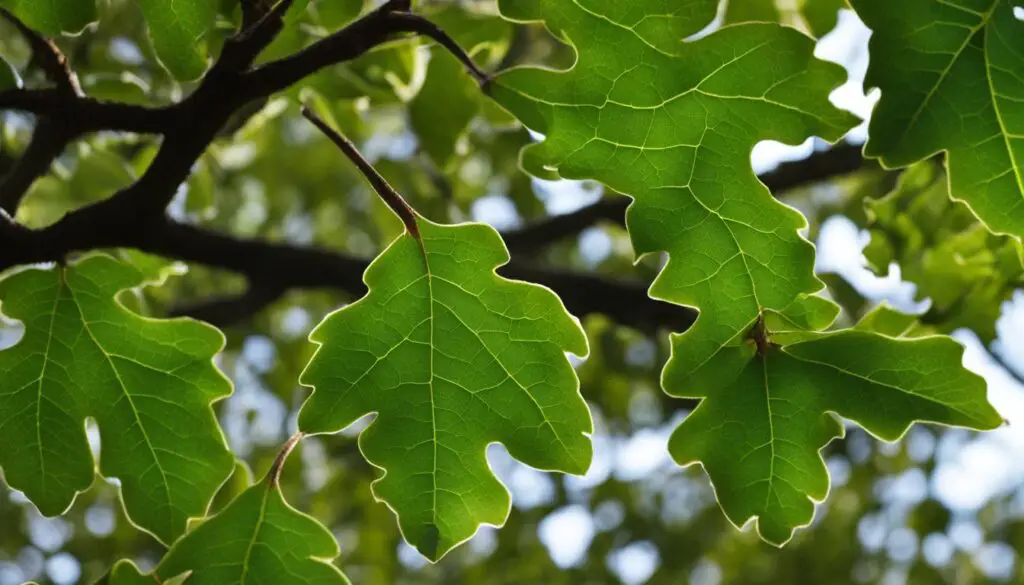If you’ve ever wondered how to identify Texas oak trees by their leaves, you’re in luck. The diverse state of Texas is home to over 50 different native oak tree species, each with its distinct characteristics. By examining the leaves of these majestic trees, you can unlock the secret to identifying the various oak species that grace the Texas landscape.
Oak trees have three primary leaf types: needles, scales, and broadleafs. The broadleaf oaks are the most common variety found in Texas and can be easily identified by their broad, flat leaves. These leaves vary in shape, color, and texture, providing valuable clues to help you determine the species of oak tree you have in your yard or the surrounding area.
Key Takeaways:
- Examining the leaves is a reliable method to identify oak tree species in Texas.
- Oak trees in Texas have three primary leaf types: needles, scales, and broadleafs.
- Pay attention to leaf characteristics such as shape, color, and texture to determine the species.
- Texas is home to over 50 different native oak tree species.
- Understanding oak tree identification enhances your appreciation for Texas’s native flora.
Common Oak Varieties That Grow Best in Texas
In Texas, there are several common oak varieties that thrive in the local climate. Each of these oak trees has unique leaf characteristics that can help you identify them. Let’s take a closer look at some of the oak species found in Texas:
- Red Oak: Red Oaks have toothed, light green leaves with 6 or 7 lobes.
- Mexican Oak: Mexican Oak trees have semi-evergreen leaves that can vary in shape and color throughout the seasons.
- Live Oak: Live Oak trees have evergreen leaves with a shiny, dark green upper half and a grey-green lower half.
- Lacey Oak: Lacey Oaks have thick, oblong leaves that come in a range of colors throughout the year.
- Chinquapin Oak: Chinquapin Oak trees have oblong-shaped leaves with a coarsely toothed edge.
- Bur Oak: Bur Oak trees have large acorns and impressive leaves that can reach up to a foot in length.
- Post Oak: Post Oaks have distinct leaves with shallow lobes and a smooth texture.
- Water Oak: Water Oak trees have classic oak leaf shapes, with tips that have 3 lobes.
- Texas Red Oak: Texas Red Oak trees have unique leaf characteristics that help differentiate them from other oak species found in Texas.
By familiarizing yourself with the leaf characteristics of these oak varieties, you’ll be able to better identify oak trees in Texas and appreciate the diversity they bring to the landscape.
How to Identify Red Oak Trees in Texas
When it comes to identifying red oak trees in Texas, their distinctive leaves play a crucial role. These leaves are light green with toothed edges and typically have 6 or 7 lobes. The center of the leaves is indented, while the edges are adorned with two small points on each side. Although the tips of the leaves are pointed, they are not sharp. What sets red oaks apart from white oaks is their pointed lobes, as white oaks usually have rounded lobes.

By closely observing these leaf characteristics, you can confidently identify red oak trees in Texas. Remember, leaf shape and lobe structure are key distinguishing factors when differentiating red oaks from other oak species.
How to Identify Mexican Oak Trees in Texas
Mexican Oak trees can be recognized by their dark to light grey bark and semi-evergreen leaves. The leaves of Mexican Oak trees are smooth, 2 to 5 inches long, and can vary in shape and color throughout the seasons. In spring, new foliage emerges with a bronze or pinkish hue before turning to a blue-ish green color. The edges of the leaves are often serrated, adding to their distinctive appearance.
Identifying Mexican Oak trees in Texas can be an exciting adventure. By closely examining the bark and leaves, you can confidently determine if you have a Mexican Oak tree in your surroundings. The unique serrated edges of the leaves and their varying colors throughout the seasons are key characteristics to look out for.
| Leaf Characteristics | Bark Characteristics |
|---|---|
| Smooth leaves | Dark to light grey bark |
| 2 to 5 inches long | |
| Varying shapes and colors | |
| Serrated edges |
Next time you come across a Mexican Oak tree in Texas, take a moment to appreciate its unique leaf characteristics and intriguing beauty. These trees are an important part of Texas’s oak tree diversity, providing shade and natural beauty to the landscape.
How to Identify Live Oak Trees in Texas
Live Oak trees are revered for their majestic beauty and are a cherished symbol of Texas. These magnificent trees can be easily identified by their distinctive leaf characteristics. Let’s dive into the key features that will help you recognize a Live Oak tree.
The leaves of Live Oak trees are evergreen, meaning they remain on the tree throughout the winter months. This unique trait sets them apart from many other oak species that shed their leaves in the fall. The leaves have a shiny, dark green finish on the top half, while the bottom half is a gray-green color. This color contrast is a telltale sign of a Live Oak tree.
When you examine a Live Oak leaf, you’ll notice that it has a smooth, leather-like texture. The leaves are oblong in shape, resembling flat paddles, and typically measure around 2 to 5 inches in length. These characteristics contribute to the overall elegance and charm of the Live Oak.

Live Oak trees are commonly found in Texas and thrive in various environments, from cities to countryside landscapes. Their lush green canopy provides shade and beauty, making them a beloved sight in parks, residential areas, and historic sites.
To summarize, when identifying a Live Oak tree, look for the following characteristics:
- Evergreen leaves that remain on the tree throughout the year
- Shiny, dark green top half and gray-green bottom half
- Smooth, leather-like texture
- Oblong-shaped leaves measuring around 2 to 5 inches in length
Now that you’re familiar with the unique leaf characteristics of Live Oak trees, you’ll be able to easily identify them as you explore the beautiful landscapes of Texas.
How to Identify Lacey Oak Trees in Texas
Lacey Oak trees are a distinctive species found in Texas with unique leaf characteristics that set them apart from other oak tree varieties. By learning to identify the distinguishing features of Lacey Oak leaves, you can confidently recognize these beautiful trees.
Lacey Oak leaves are thick and oblong in shape, adding a robust presence to the tree’s overall appearance. One notable aspect of Lacey Oak leaves is their range of colors throughout the year. In spring and autumn, the leaves take on a delightful peachy hue, creating an enchanting display of colors. As summer sets in, the leaves transition to a deep blue or grey-green shade, enhancing the tree’s attractiveness.
When examining Lacey Oak leaves, you’ll notice that they typically have only a few shallow lobes, which distinguishes them from other oak species with more complex lobe formations. The smooth texture of Lacey Oak leaves further contributes to their unique visual appeal.
The image above showcases the characteristic features of Lacey Oak leaves, including their oblong shape, color variations, and minimal lobes.
By familiarizing yourself with the distinctive characteristics of Lacey Oak leaves, you can easily differentiate them from other oak tree species in Texas. The combination of their thick, oblong leaves and the ever-changing colors they exhibit throughout the year make Lacey Oaks a remarkable addition to any landscape.
How to Identify Chinquapin Oak Trees in Texas
Chinquapin Oak trees, native to Texas, are highly adaptable to various soil conditions. One of the key features that help in their identification is their oblong-shaped leaves. These leaves measure about 4 to 6 inches in length and have a coarsely toothed edge, giving them a distinctive appearance.
The primary color of Chinquapin Oak leaves is a dark yellowed green, which provides a striking contrast against other foliage. During autumn, these leaves undergo a stunning transformation, displaying a range of shades including yellow, orange, bronze, and brown. This vibrant display adds to the tree’s appeal and makes it easier to spot amidst the fall landscape.
To aid in the identification of Chinquapin Oak trees, pay close attention to their characteristic leaf shape, size, and coloration. These unique leaf features make Chinquapin Oaks stand out and enable you to differentiate them from other oak species.
If you’re unsure about the appearance of Chinquapin Oak leaves, refer to the image below for a visual reference:
How to Identify Bur Oak Trees in Texas
Bur Oak trees are easily recognizable due to their unique characteristics, including their large acorns and impressive leaf size. If you come across a tree with these distinct features, it’s likely a Bur Oak tree.

Characteristics of Bur Oak Trees
One key characteristic of Bur Oak trees is their large acorns. The acorns have very large cups that practically envelop the whole nut, making them stand out from other oak tree species. Additionally, Bur Oak leaves are equally impressive, reaching up to a foot in length. The leaves are generally wide with blunt lobes, giving them a distinct appearance.
By identifying these unique features, you can confidently recognize and differentiate Bur Oak trees from other oak tree species in Texas.
How to Identify Water Oak Trees in Texas
Water Oak trees are a common sight in Texas, and being able to identify them is essential for any nature enthusiast. These trees exhibit classic oak leaf shapes, but what sets them apart is their variable size. The size of their leaves can range from small to large, making them distinct from other oak tree species.
In summer, the leaves of Water Oak trees take on a subdued blue-green color, adding a touch of serenity to the landscape. However, it’s during autumn that these trees truly come alive with vibrant hues. As the season changes, the Water Oak leaves transform into a brilliant yellow, creating a stunning display of color.
An easily recognizable characteristic of Water Oak leaves is the presence of three lobes at the tips. This distinct feature further helps in identifying these trees. By observing these leaf characteristics, you can confidently differentiate Water Oak trees from other oak species found in Texas.

With its unique leaf structure and striking color changes, the Water Oak tree adds beauty and diversity to the Texas landscape. Keep an eye out for these magnificent trees in your surroundings and appreciate their distinguishing features.
Conclusion
Identifying Texas Oak trees by their leaves is a crucial skill for anyone interested in the diverse flora of the Lone Star State. By carefully observing leaf characteristics such as shape, color, texture, and lobes, you can successfully identify various oak tree species native to Texas. Each oak variety possesses unique leaf features that distinguish it from others, making the identification process more accurate and exciting.
Remember that leaf identification should be complemented by considering other factors such as the overall size of the tree, the bark’s appearance, and the characteristics of its acorns. Examining these additional features in conjunction with the leaves will help you achieve more precise identification results.
With the knowledge gained from this comprehensive guide, you’ll be empowered to confidently recognize and appreciate the many oak tree species that flourish in Texas. Whether you’re an outdoor enthusiast or simply curious about the natural beauty around you, understanding oak tree identification will enhance your connection with the rich ecosystem of Texas.
FAQ
How can I identify Texas oak trees by their leaves?
One of the most effective ways to identify Texas oak trees is by examining their leaves. By studying the characteristics of the leaves, such as shape, color, and texture, you can determine the species of oak tree you have in your yard.
How many different native oak tree varieties are there in Texas?
Texas is home to over 50 different native oak tree varieties.
What are the primary leaf types of oak trees?
Oak trees have three primary leaf types: needles, scales, and broadleafs.
Which oak tree varieties grow best in Texas?
Some common oak varieties that thrive in the Texas climate include the Red Oak, Mexican Oak, Live Oak, Lacey Oak, Chinquapin Oak, Bur Oak, Post Oak, Water Oak, and Texas Red Oak.
How can I identify Red Oak trees in Texas?
Red Oak trees can be identified by their toothed light green leaves with 6 or 7 lobes. The edges of the leaves have two small points on each side, and the tips are pointed but not sharp.
How can I identify Mexican Oak trees in Texas?
Mexican Oak trees can be recognized by their dark to light grey bark and semi-evergreen leaves. The leaves are smooth, 2 to 5 inches long, and can vary in shape and color throughout the seasons.
How can I identify Live Oak trees in Texas?
Live Oak trees are known for their evergreen leaves, which often stay on the limbs throughout the winter. The leaves have a shiny, dark green finish on the top half and a grey-green color on the bottom half. They also have a leather-like texture and are typically oblong in shape.
How can I identify Lacey Oak trees in Texas?
Lacey Oak trees have thick, oblong leaves that come in a wide range of colors throughout the year. In spring and autumn, the leaves have a peachy hue, while in summer, they turn dark blue or grey-green. Lacey Oak leaves typically have only a few shallow lobes and a smooth texture.
How can I identify Chinquapin Oak trees in Texas?
Chinquapin Oak trees can be recognized by their oblong-shaped leaves. These leaves are about 4 to 6 inches long and have a coarsely toothed edge. The primary color of the leaves is a dark yellowed green, but they can turn various shades in autumn.
How can I identify Bur Oak trees in Texas?
Bur Oak trees stand out due to their large acorns and impressive leaf size. The acorns of Bur Oaks have very large cups that practically envelop the whole nut. The leaves of Bur Oak trees are also impressive, reaching up to a foot in length and being generally wide with blunt lobes.
How can I identify Water Oak trees in Texas?
Water Oak trees have classic oak leaf shapes, but their size can vary greatly. In summer, Water Oak leaves have a subdued blue-green color, while in autumn, they turn a brilliant yellow hue. The tips of Water Oak leaves have 3 lobes, adding to their distinctive appearance.
How can I identify oak trees in Texas?
By observing leaf characteristics such as shape, color, texture, and lobes, you can identify various oak tree species in Texas. Remember to consider the overall size, bark, and acorn characteristics in conjunction with the leaves for accurate identification.

